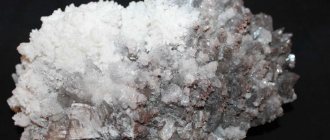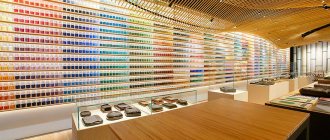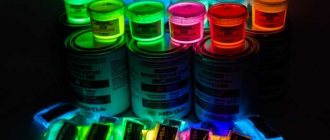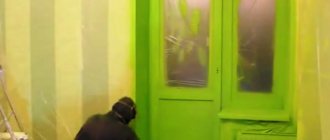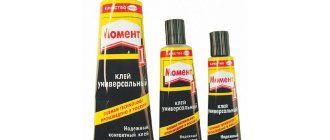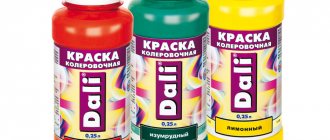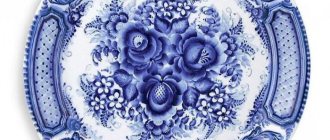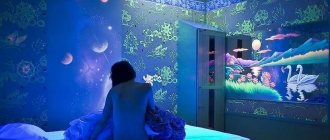Gold color in paint
Author Ivan Ivanushkin asked a question in the Software section
How to make a golden color in Paint? and got the best answer
Answer from Kukuyev Kukuyffd700 color code 255 215 0 in RGB encoding
https://youtube.com/watch?v=MiMfSJ5CTfs
Any work painted with paints contains a huge range of different colors. And, of course, not all of the colors an artist needs are freely available to him. Therefore, since ancient times, people began to practice mixing different shades with each other. And what colors to mix to obtain the desired shade was experimentally found out by ancient artists. As a result, general rules emerged that govern all color relationships.
Shades of gold
There are a huge variety of colors in the world: some of them are pleasing to the eye, while others are not successful on their own, but together with other shades they become quite interesting. How often do you look around? Have you noticed that certain color palettes are more often used for urban gentrification or billboard designs? One of these popular colors today is gold. This color is very rich and all its variations look quite noble. But it, like almost any color, can be obtained by mixing. Therefore, if suddenly you need gold, but you don’t have a ready-made jar of paint, we suggest you figure out how to make gold from other color palettes. Mostly gouache and acrylic paints were used for mixing, so some methods may not be useful when working with other materials.
Golden color in clothes, wardrobe selection:
Heat-shrink tubing.
characteristics, area of application Gold color in clothing is most often used in an evening wardrobe, however, some shades are also available for everyday wear, but this will be an expensive, feminine, slightly pretentious style.
Gold color is good for a mature woman. If the lady is aged, then in combination with gold, every wrinkle on her face will look noble. If a woman is young, then she will need a good figure for the gold color (since it makes her look fat), but if she has one, the gold color will make her a goddess worthy of worship. Light tones of gold are suitable for little girls: yellow, pale, pink, but you should not overdo them: moderate use of gold tones will make an angel out of a girl, but too much will look vulgar.
Gold and silver sparkles
Types and characteristics of metal paints
Metal in the interior is especially relevant today. Even small accessories like boxes, cornices, candlesticks, if given a shiny look, completely change the impression of the apartment. The easiest way to transform them is with metallic glitter or metallic paint in an aerosol can. Working with these materials is interesting, easy and pleasant.
As if by magic, you can literally prepare for Christmas in half an hour. Household items like nuts, pebbles, and shaped pumpkins actually have a wider range of uses than is commonly believed. Especially if the surface, sparkling with gold and silver, is illuminated with candles.
Apply a layer of glue to the box with a brush and, while it is still wet, sprinkle with small glitter. Spread the glitter with your hands, making sure that the surface is covered evenly. A wonderful decoration for a dressing table.
Color in the painting
Use of penofol: main characteristics of the material and scope of application
To paint any picture, the artist needs only a few colors, but in two different colors:
Achromatic colors include:
As for the chromatic scale, you only need three colors:
Mixing paints
Try to take three jars of gouache and get all the other colors that we see in the spectrum:
- red and yellow colors produce orange;
- the result of mixing yellow and blue will be green;
- By combining red and blue, you get purple.
Adding white
Painting colors can be:
The most popular type of transparent paint is watercolor. All the previous ones are visible through each new layer, so you can get, say, pink or blue in only one way - dilute red or blue paint with water.
Opaque paints – oil and gouache. They can be applied in a continuous layer so that neither the canvas or paper nor the previous layers are visible. Gouache, of course, is also diluted with water, just like watercolor. But light colors are obtained in a completely different way. White is added to the palette. The more white you add, the lighter the tone.
Gold paint on the painting
The golden color is also obtained by mixing paints. It's close to yellow, but not quite. You can't call it orange either. However, it is obtained by mixing yellow and red. True, not every red is suitable, but only royal or red-brown. And you need very little of it, just a few drops on a standard jar of gouache.
So, how to make gold color from gouache:
- If the gouache has dried, dilute it with water and stir until it has the consistency of thick sour cream.
- Add a little carmine to the jar of yellow strontium and stir to form a homogeneous mass, without fractions.
We do the same with oils, but with watercolors the situation is more interesting. Of course, you can mix paints on the palette, but nothing prevents you from doing this on the drawing itself to make a golden color:
- Apply a layer of bright yellow watercolor to the desired area.
- Add a couple of drops of red and blur depending on the shape of the object being depicted. For example, on domes, the color on one side will be lighter than on the other, depending on where the light hits).
How to make gold color from gouache?
Sometimes gouache has to be used not only to create paintings, but also to cover some other decorative items. For example, a bas-relief made of plasticine and primed with water-based emulsion.
The traditional painting method is not suitable here. You need:
The technology by which you can make a golden color is available to anyone:
- Dilute the gouache to the desired consistency.
- Add bronze to it.
- Cover the desired area of the terrain.
- Cover the top of your entire creation with varnish.
Let's sit down at the computer
What if you need to make a postcard and send it by email? Nothing supernatural. Your equipment has such capabilities, if only it has Adobe Photoshop.
In this program you can get gold color:
- for image;
- for text.
Oddly enough, in order to get any shade, the computer needs only three colors - just like an artist who paints with paints. True, the set of colors is somewhat different. It includes:
- red;
- green;
- blue.
The very process of obtaining the desired shades consists of changing the intensity and relative position in the structure of a particular picture. The gold color in this scheme is not at all unusual.
Turning lead into gold
To feel like an alchemist, find any picture where there is something lead-gray. For example, a car. Open the image in Photoshop.
Important! The GIF format is most suitable for experiments.
It is best to take a picture where the background layer is transparent. In this case, the graphic editor can easily determine the contours of the main image. Why is this necessary? Then, so as not to mess with the background, but work only with the image.
Curves
The tool that allows you to turn lead into gold is called “Curves”. You can find it in the top menu, in the “Image” – “Adjustments” tab.
Important! When you open the tab, a panel will appear in front of you, at the top of which there is a window. By default, it is RGB, but you can also set the names of the primary colors.
Further:
- Darken the image by moving the curve back a little - you will see the result in the picture.
- Move the curves of red, green and blue colors in turn.
- Take the red curve back, that is, to the top line.
- The curves of blue and green - on the contrary, take them to the bottom line.
- Try different positions of the curves.
Important! Once you have a color close to what you want, try experimenting with the effects - you will find the corresponding functions in the “Filters” tab.
Gold text
Open a picture in Photoshop and add text to it (to do this, find the picture with the letter T in the toolbar). It will be in alphabetic format, but you need a graphical one:
- Select the Rectangular Marquee Tool (rectangular area).
- Right click on the text.
- Select Rasterize Layer.
- And then process the drawing in the same way as in the previous case.
Important! Before rasterizing the text, check it carefully - after such processing, errors cannot be corrected.
Combine gold with other colors
Gold is a shade of yellow and orange, which means it combines with the colors that suit its “parents”. When choosing the right shade, you should also rely on color tables. For example, colors that contrast and therefore highlight gold are shades of purple. In addition, gold goes well with black and white colors.
Fine gold also looks good surrounded by dark orange and burgundy colors, and can also be combined with some shades of dark green. When choosing a “neighbor” for a certain color, it is better to adhere to the already established rules, because even the most pleasant color, being next to an inappropriate shade for it, can become repulsive.
Features of gold coloring compositions
High-quality gold paint for decoration will allow you to change the interior of any home. This design causes genuine delight and is combined with different styles.
Using golden shades, you can get an unusual design effect and decorate the walls with original artistic paintings. For this purpose, there are compositions with metallization and a wide range of colors.
The gold finish is suitable for surfaces made of metal, wood, plastic, ceramics and glass. In addition, it is used in the processing of styrofoam products. Almost all parts of the room are treated (from the flooring to the ceiling). Acrylic paints and varnishes are in particular demand. They are superior in properties to mixtures based on oils and alkyd components.
Color variety
A series of paints and varnishes with different shades are suitable for interior decoration.
Among the most interesting are:
- Rose gold paint.
- Gold chrome.
- Matt chrome.
- Old gold.
- Antique gold.
- Black aged metal.
By mixing several options you can get an interesting shade.
Classification of paints
Gold-plated paints and varnishes differ in composition and properties. Each type performs special functions. For example, water series are used for interior finishing work and are suitable for wood. Oil and alkyd mixtures are designed for metal.
Golden chrome is a paint for connoisseurs of creative design. The composition is used for decorating and restoring souvenirs, kitchen accessories, plaster structures and other items. Even outdated specimens acquire a fresh and well-groomed appearance after staining.
Dry powders require mixing with water. The finished consistency is easily distributed over surfaces, and in most cases it is used for wood furniture.
Golden paintwork materials are popular among artists, icon painters and specialists in the restoration of ancient objects.
A separate group includes forging substances. Their name explains the main scope of application. Such options are used for painting metal fences, bas-reliefs and gates. There are compounds available on the market that create the effect of an old metal texture or a surface that has been beaten with a hammer.
Forge paints are used for decorative finishing of metal surfaces.
Experts combine several types of paints at the same time to achieve unusual effects. But with such manipulations, you need to adhere to the correct proportions so as not to deteriorate the aesthetics of the product being painted.
Types of decorative compositions
Wooden and metal surfaces, ceramics, glass and plastic can be finished in gold. You can process everything - from ceiling to floor. Decorative acrylic paint is popular. It is superior to alkyd and oil compositions in many respects.
Advantages of acrylic compositions
The composition can be used both for decoration and for restoration work on metal and wood. With its help you can paint polyurethane and gypsum stucco. Manufacturers produce the coloring composition in several types:
- classic paint in a sealed metal can - enamel;
- aerosol paint in spray cans;
- dry, in the form of a powder composition that needs to be dissolved.
Each type of decorative acrylic paint has different characteristics, color and application features.
Acrylic based
There are a lot of manufacturers of golden paint, and any enamel is of good quality. An example is Metallic Accents acrylic decorative paint.
The substance contains mica particles, which give the coating a golden shine and a magnificent shimmering effect. The manufacturer offers a varied color palette from light gold to dark brown paint. Enamel is suitable for any interior style; it can be used to paint wallpaper, wood furniture, walls, and it is suitable for ceramic tile floors. For work use:
After application, the layer of acrylic enamel must be coated with a finishing varnish to protect and secure the composition.
To create a beautifully distressed antique look, Aerican Accents can be used with a light patina effect. Acrylic paint is produced by the manufacturer in a small jar complete with a base and top coat. It can be used to paint surfaces made of metal, plastic, plaster, wood, and ceramics indoors and outdoors.
An antique patinated coating is obtained by applying all enamel components:
- The first layer is to first apply the primer in cans (included in the kit) to the prepared, cleaned surface, following the manufacturer’s instructions.
- The second main layer - the enamel is mixed and applied in a thin layer. In the right places, the paint is immediately wiped down to the base layer to create a patina effect. The more second layer remains, the more aged the antique finish looks.
The composition is two-component. Dries in twenty minutes, suitable for interior and exterior decoration in an old style. In general, to get a brown patina, use any acrylic metallic paint of bronze and gold color. The surface is cleaned, degreased, base gold is applied, then bronze and clear varnish. As a result, you can get a spectacularly aged brown patina with an excellent antique imitation.
Acrylic paint in a can is a classic way to paint a surface, giving it the effect of an antique patina, antique coating, or Venetian plaster.
Gold items
What to do if you need to coat jewelry, figurine or furniture with gold paint? You can't get away with mixing red and yellow; you'll have to make gold paint.
For this you will need:
- bronze or gold powder;
- nitrovarnish or oil:
- glass jar;
- wooden stick.
Gold powder can be purchased at stores that sell artist supplies. Of course, she will give the most natural color. But it has one significant drawback - it is quite expensive. Bronze will cost much less, and you can buy it at a hardware store. They are almost the same in color.
Important! Gold powder is more suitable for small jewelry; bronze powder can be used for larger items.
Coloring methods
There are two ways to use bronze or gold powder:
- dilute in varnish;
- paint the product using the dusting method.
Making dye
To make gold paint, in principle, any varnish is suitable, but most often they use oil or nitro. There is no big difference in price, but oil-based dries much slower.
To use this tool:
- Pour the varnish into a glass jar.
- Slowly pour in the bronze powder, stirring constantly.
- Stir the composition so that it is homogeneous, without accumulations of powder, and thick enough (preferably so that there are no colorless spaces between grains of bronze).
- Paint the product with a brush or cotton swab (the first method is better).
- Let things dry.
- Adjust the coating so that the layer is even throughout.
Important! The advantage of this method is that the product does not require additional processing after it has been gilded
Spraying method
In this case, a layer of powder is applied on top of the varnish:
- Pour the powder into a jar large enough to fit the product.
- Cover the item with oil or nitro varnish.
- Place it in a jar of powder.
Important! The main disadvantage of this method is that after processing the product sheds for quite a long time. To prevent this from happening, it is covered with another layer of varnish on top.
At the same time, if the first layer was oil-based, then nitro varnish should be applied on top of the powder (and vice versa).
A little about surfaces
Oil-based gold paint can be used to cover any surface:
As for nitro varnish, it is certainly suitable for metal and wooden products, but not always for plastic. If you need a gold-plated plastic hoop to dry quickly, try first applying a few drops of nitro varnish to an inconspicuous place and see if it begins to dissolve the plastic or not.
Important! Silver paint is obtained in exactly the same way, only the powder needed is not bronze, but aluminum
Mixing acrylic-based materials
Designers love acrylic paints the most. They are very easy to work with, and the finished coating has excellent water-repellent properties. Their use has several nuances:
The working surface must be perfectly flat and smooth
To do this, it needs to be sanded. It is important that the paint does not dry out. To obtain an opaque color, use undiluted paint. Conversely, you can add a little water for transparency. To be able to quickly select the desired color, it is recommended to use a thinner for acrylic paints
Thanks to it, the product will not dry out so quickly. Use the edge of the brush to distribute the paint. Mixing is best done with a clean instrument. In this case, the colors should be directed towards each other. To make a light tone, you need to add white dye to the solution, and to get a dark one, add black. It is worth remembering that the palette of dark colors is much wider than light ones.
Here are some examples of mixing acrylic-based paints:
- Apricot color is obtained by mixing red, yellow, brown and white.
- The recipe for making beige paint involves combining brown and white. If you want a bright beige, you can add a little yellow. For a light beige shade you will need more white.
- Gold is the result of mixing yellow and red colors.
- Ocher is yellow and brown. By the way, it is considered popular this season.
- Khaki can be made by mixing green dye with brown.
- To get purple you need three different colors: red, yellow and blue.
Outlandish dark colors
Gold jewelry created from darkish shades of the precious metal is gaining immense popularity. For example, if previously brown gold, characterized by high strength, was mainly used in the production of wristwatch cases, now it is often found in decorative jewelry. As a rule, brown gold has two types of fineness - 585 and 750.
The brown-red hue is obtained by combining such components.
| Ligatures | Quantity |
| gold | 18 parts |
| copper | 13 parts |
| silver | 11 parts |
| palladium | 6 parts |
But the brown tint is obtained not so much as a result of the combination of these metals, but as a result of repeated special chemical treatment. The key point is that the finished piece of jewelry is being processed. In order to create gold with a gray or black color, specialists use several methodologies. To begin with, an alloy is prepared consisting of:
- gold - 30 parts;
- silver - 8 parts;
- steel - 2 parts.
The item is then electroplated (coating the item with a very thin layer of metal film), which can result in a color ranging from light gray to graphite and even radical black. To create the effect of black gold, jewelry can be rhodium-plated (applying rhodium to the surface) or coated with a layer of amorphous carbon. Some specialists in their work use ruthenium (a silver-colored metal) instead of rhodium.
There is an option to create 750-karat black gold items with a special composition. The alloy uses not silver and steel as alloys, but cobalt and chromium. The key point of this method is the exposure of the product to high temperatures. As a result, an oxidation process occurs, and the surface of the object acquires a characteristic black color.
Gold in crimson tones
Close in composition to pink, the metal is red in color; previously it was also called red. Its main alloys are also copper and silver, only the amount of the first metal is greater. The best standard of red gold is 585. This composition has a pleasant golden color with a noticeable red tint. The rich red color is achieved by craftsmen by reducing the amount of silver in the alloy and increasing the amount of copper. But if you add palladium to it, then the gold will acquire an unusual brown tint with a red tint.
At the same time, jewelers need to strike a balance between achieving a bright red color and the amount of copper. The problem is that copper is prone to oxidation. And if you add too much of it to the product, then after a short time its surface will fade and even become covered with a film of copper oxide.
There is also 375 red gold, which is not very valued by people due to its low precious metal content. At the same time, it can be used in other higher-quality jewelry as decoration, as it has an unusual orange color. To obtain it, craftsmen increase the amount of silver in the composition.
Almost half of our jewelry market is occupied by jewelry made specifically from red gold. It is less expensive than yellow, which adds to its appeal among a wide range of buyers. In addition, it has been noted that it is less susceptible to mechanical damage, such as scratches, which cannot be avoided when wearing jewelry constantly. That’s why many people prefer to choose jewelry of this particular color as an everyday accessory.
https://youtube.com/watch?v=oLX0BtlhQuw
What is remarkable about blacksmith's paints?
Since painting allows you to obtain interesting surfaces with different effects, it is used to decorate exteriors - gates, window bars, entrance doors and panels, bas-reliefs, fences (including painting fences in a cemetery). With the help of blacksmith's gold paints, it is possible to obtain an unusual surface with shiny chrome, artistic painting, or artificially age the metal.
Hammer compounds are very popular, which give the metal texture the appearance of dents and relief left by a forging hammer.
The use of several blacksmith's paints allows you to achieve a stunning effect of brown patina, and there are more than fifty options for such imitation. Even an inexpensive metal surface can be given a luxurious look and architectural appeal. In addition, forge paints significantly extend the service life of the metal and additionally protect it from moisture and corrosion.
Using dry acrylic, aerosol and enamel paints, you can introduce very bold and interesting design ideas, obtain incredibly beautiful unique surfaces, and add originality and chic to the interior. The only rule to follow is that there should not be too much gold. Only neat, no-frills gold accents will look appropriate and beautiful.
Red and gold
The combination of red and gold is extremely festive, bright, and feminine. It combines the charm and attractiveness of a woman in red and the regal inaccessibility of a golden lady
But you should be careful with this combination, since both red and gold play towards expanding space
Red white gold
A noble, bright and contrasting combination, filled with freshness. Ideal for a New Year's party, as well as for formal banquets. The white color balances the flashy ostentation of the red and gold, giving the object the modesty and restraint of a well-mannered lady.
Red-black-gold
In this case, black adds a more modest evening note, although remaining within the limits of severity. A bright classic look will look good in any formal atmosphere.
How to get pink using other colors
Many colors available can be created by mixing paints.
There is a base (basis): it is blue, yellow and red. There are also neutral tones: white, black.
With the help of the latter you can get many different tones. For example, green can be made by mixing yellow and blue.
The most beautiful of pink colors is considered to be the shade of rosehip flower petals. This is a warm and gentle tone, very eye-catching.
The method for obtaining it differs slightly depending on what type of coloring agent was taken.
There are a lot of varieties of pink, so you need to experiment.
Using Paints for Artists
So, to get a delicate shade of pink you need to do the following:
- Gouache. You need to take the same proportions of red and white. Stirring will result in a deep pink color. Next, add a white tone until the desired shade is achieved. After the paint has dried a little, it becomes a little lighter; this must be remembered when obtaining the desired shade.
- Acrylic paints. The process will be the same: add as much white to the red color until you get the desired result.
- Watercolor. The regular set includes the shade carmine. You can add water to it and get the desired shade. The brightness will depend on how much water is added. There are few color options in such paints, but there is also red, so it is this that is taken to obtain our color scheme.
- Oil based paints. Getting pink from such paints is problematic. It is better to add titanium white to the red tone, but you will need a lot of it. Therefore, it will be easier to do it wrong - add a small amount of red to white.
Use of paints for construction
There are manufacturers who make paints with mixed colors, although they may differ in color from the sample presented in the store.
Therefore, a good option would be to buy a regular white color (paint based on acrylic, latex) and buy the pigment separately.
The resulting version is applied to a small area of the surface. After drying, you need to evaluate whether this color is suitable or not.
Red paint is also added to white; it is better to buy it in small quantities.
There are a lot of different tones in paint and varnish materials for construction, so choosing what you need should not be a problem.
Paints with a glossy sheen will be more saturated, but those with a matte effect will not have such a bright color.
Pink food coloring
The work goes like this:
- Powder in the required quantity is poured into the container.
- Add a little water or leave it like that.
- Pour in a small amount of color (about a drop, because this product has a high concentration).
- Everything is mixed well (use a mixer or blender for this).
This product can be used to coat any confectionery product; it perfectly replaces plain white powder and looks unusual.
How to get fuchsia pink by mixing paints?
Bright, cold pink, according to some theories, is considered a primary color, so you can get red from it, but from red we cannot get fuchsia, but only imitate its pale likeness. So, for example, take red paint, white, blue (ultramarine), mix in proportions of approximately 100:30:5 and get a medium, cool pink color, reminiscent of fuchsia.
If, to obtain the desired color, we take not warm red paint, but carmine, a rich purple-red color, then we will not have to resort to blue, since even lightly highlighting it will give the desired effect. Very light dilution gives a rich raspberry color, and a little more intense dilution gives fuchsia or magenta.
How to get a medium pink warm or cool?
Rich fuchsia in a pink palette is the exception rather than the rule. The main range of tones lies in the light area and therefore a sufficient amount of white helps to form many shades of pink: both warm and cold. Mixing white and red, with both fiery and purple undertones, leads to the formation of a palette of this color. Carmine and white, which is at least half of the first component and more (with increasing lightness), form soft, medium-cold, pure pink paints.
Dark red and white, which has no less share than in the previous case, create soft, warm tones of pink.
However, these colors can be made even warmer by adding a small amount of yellow.
In general, these will turn out to be coral-pink tones, which, with increasing lightness, will gain the aesthetics of pink.
How to mix paint colors correctly
As you know, there are only 4 primary colors - white, red, green and blue. All other colors are obtained by combining the listed colors in different proportions with each other. Despite the rich color palette of paints that manufacturers offer, sometimes you need a non-standard shade or you need a color now, but “as per the law of meanness” it is not on sale today. Here I will tell you how you can get different colors and shades in different types of paints.
Let's start with how to get colors by mixing water-based paints. It's all just paints that belong to the family of water-based paints, sold only in white. To obtain other colors, stores sell tints (pigment concentrates) for these paints. There are many manufacturers of colors, as well as shades, it is not difficult to buy. Please note that these colors are only suitable for water-based paints, i.e. for paints that can be diluted with water (this is written on the paint container). To obtain high-quality color, mix the color with paint using a mixer.
How to mix colors of oil paints This is more difficult than with water-based paints. They don't sell colors for them. Such paints are usually of two types: Oil paints - which are diluted with white spirit or drying oil (in Soviet times), Nitro paints - which are diluted with a solvent and have a pungent odor. You can only mix paints of one type, you cannot mix oil paint with nitro paint, nothing good will come from it will come out. As I said, there are no colors for such paints, which means you need to buy paints of different colors and mix them. To understand what paint colors you should buy in order to achieve the desired color, I provide a table.
Example: red + yellow = orange red + ocher + white = apricot red + green = brown red + blue = violet red + blue + green = black yellow + white + green = lemon yellow + light blue or blue = green yellow + brown = ocher yellow + green + white + red = tobacco blue + green = sea wave orange + brown = terracotta red + white = café au lait brown + white + yellow = beige
I would like to give advice on how to properly mix paint colors - take a small container and experiment with mixing paints in it until you get the desired color or shade. This way you will know approximately the proportions of the required paints and will not spoil large jars of paint if the color combination is not successful.
22 types of premises Calculation of the area of walls, ceilings, floors. Subtraction of up to 9 windows and doors. Calculation of slopes. Calculation of the cost of work and materials. Saving results.
Message #1 16/3/2014 10:05
It’s easier to order paint tinting from specialized stores or companies. There you will not only choose the exact color, but you will also know the color and shade number. This is necessary so that if there is not enough paint, you can buy exactly this color and shade, because... This paint is mixed by a computer. You won’t be able to mix the paint manually; you will definitely not guess with the shade. Mixing paint “in reserve” is not always financially profitable, compared to paying extra for computer tinting.
Apartment renovation in Kaluga
Message #2 9/4/2014 2:40
Somehow they were painting the fence. There wasn't enough paint and we decided to look to see if anyone else had supplies. In the end, we mixed everything we had, but the color turned out quite nice. But this is for painting something that does not carry any “load”, so to speak. In general, it’s better to actually order tinting.
How to mix paint colors correctly
As you know, there are only 4 primary colors - white, red, green and blue. All other colors are obtained by combining the listed colors in different
Paint color mixing table
Detailed color mixing chart with examples and mixing instructions.
For many artists, especially beginners, the problem of mixing paints can be very pressing.
How to get a color that you don't have on hand? Of course, mix paints on the palette! And the color mixing table below will help you get the most necessary colors for oil painting. The table describes in detail how and what paints to mix to get different colors. The table will expand your horizons and add courage to beginning artists in mixing paints, because to obtain a color you need to mix several paints of 2-3 and 4 types to obtain one shade.
Base Color + Mixing Instructions
The working process
By mixing several different colors, you can get a large number of different shades. Which ones?
Shades of Gray
Quite often used in interior decoration. They help create shadow or unobtrusive color, as well as:
- You can create a regular gray by mixing black and white.
- To create cool shades, you need to add a little green to gray, and ocher for warm shades.
- Grey-green is gray with white and green.
- Gray-blue - gray, white and a little blue.
- Dark gray is the result of mixing gray and black.
Brown tones
To get a rich brown dye, you need to mix:
- green with red;
- red with blue and yellow;
- red with white, black and yellow.
How to create other original tones:
- You can get mustard if you add red, green and black dyes to yellow paint.
- Tobacco shade is red, green, yellow and white.
- Golden brown is the result of a combination of yellow, red, green, white and blue. In this case, there should be more yellow pigment.
Red tones
- The basis for the pink shade is considered to be white. Red is added to it. The brighter the desired shade, the more red you should add.
- To get a rich chestnut color, you need to mix red and black.
- Bright red-orange color - red and a little yellow. The more of the latter, the paler the result will be.
- You can give the dye a purple tint by mixing a few drops of bright blue and yellow colors and red pigment.
- To create raspberry, according to the recipe, you need to mix bright red + white + brown + blue. The more white, the pinker the hue.
Green tones
Deep green color is formed by combining yellow and blue tones. The saturation of the finished dye depends on the amount of each of them. To create shades, you need to add other colors to green:
- For mint you will need white.
- To obtain an olive color you need green and a few drops of yellow.
- The shade of grass can be obtained by mixing green with blue. Yellow paint will help to even out the color.
- The color of the needles is the result of mixing green with black and yellow.
- Gradually mixing green with white and yellow, you can create an emerald tone.
Violet tones
Purple is made by mixing blue and red. You can also use blue and pink paints - the final color will be light, pastel. To darken the finished tone, artists use black paint, which is added in very small portions. Here are the nuances for creating shades of purple:
- for light purple, you can dilute the finished color with white in the required ratio;
- For purple, you need to add more red paint than blue.
Orange color
When creating classic orange, combine one part of yellow and red paint. But for many types of paint you have to use more yellow, otherwise the color will turn out too dark. Here are the main shades of orange and how to get them:
- for light orange use pink and yellow, you can also add a little white paint;
- for coral, dark orange, pink, and white are required in equal proportions;
- for peach you need colors such as orange, yellow, pink, white;
- for red, you need to take dark orange and a little brown.
How_to_make_gold_color_from_pencils
Working with paints is a fascinating process. Remember how you played with watercolors as a child, mixing paints. You can also play now. Mixing colors can be useful for renovations, hobbies, etc.
Primary and secondary colors
As you know, there are three primary colors (red, blue, yellow) and three additional colors (purple, orange, green). These are the basic colors. By combining them, you can get all the other colors and their shades (in theory, yes, in practice the situation is a little different). In the figure, the primary colors are represented by circles, and additional colors are formed at the intersection of the pairs. These pairs show how mixing the colors of the main row produces additional ones.
Primary and secondary colors of the palette
In practice, mixing colors is an interesting process, but often the result is difficult to predict. We work with paints, and they are a mixture of a coloring pigment and a binder base. That is, they have their own properties due to the presence of that very base. After all, paints come in different types - oil, acrylic, aniline, etc. Accordingly, the result will be slightly different. When you work with paints from the same company for a long time, you can almost accurately predict what will happen if you add this or that component.
https://www.youtube.com/watch?v=H3iNpKv48r0
It is also worth remembering that if you mix light rather than paint, the result will be different. Paints are only a reflection of light and not all laws work with them in the same way.
Obtaining additional colors: orange, purple, green, their shades and brown
Pairwise combination of primary colors gives us additional shades:
- Orange is obtained by mixing red and yellow.
- You get purple if you add blue to red.
- Green can be obtained by mixing yellow and blue.
Mixing colors should be in equal proportions. In this case, we get a “neutral” tone. If you are not satisfied with the result obtained, you can add one of the components, “shifting” the shade in one direction or another.
Additional colors and their shades
Please note that red and blue do not always produce purple. Often this mixing of colors produces a “mud color.” This is because your red contains yellow, that is, it is not the main one, but only one of the shades. To get purple, there must be pink or purple instead of red. On the other hand, mixing pink and yellow will not produce blue. So to get a specific color, first experiment with a small amount of paints. Once you are sure of the result, you can repeat it as needed.
If we add to the resulting additional colors the primary ones that are already present in them, we get the same color, but of a different shade. We didn't introduce any new colors, we just changed the concentration of one of the existing ones. This is how we get mixed colors: yellow-orange, red-orange, red-violet, blue-violet, blue-green and light green.
How to get brown color when mixing colors of an additional row
What happens if you add one that is not in it to the additional colors? The result will be a mixture of all available primary colors, and it will give us a brown color (when working with light it will be gray, but with paints it will be either brown or very close to it). So, to get brown, you need to mix all the primary colors: yellow + red + blue. Or add “missing” to one of the additional ones:
- add yellow to purple;
- to green - red;
- add orange to blue.
That is, to get a brown color, you can mix three primary colors or add the missing primary color to the additional ones. Interestingly, if you mix the same light waves, you get gray light. But paints are only a reflection of light, so there are certain differences.
Color wheel - how to make it
If the colors - primary and secondary - are placed in a circle, according to how they turned out, we get a traditional color wheel. We divide the circle into 12 parts. At the vertices of the triangle, fill the sectors with primary colors.
Drawing up a color wheel
Their derivatives, obtained from equal shares of neighboring colors, are in the center of the sector. These are called “first-level complementary colors.” To the right and left of them we place the shades that were obtained by adding another part of the corresponding component. This is how we get our own color wheel.
Mixing colors creates a color wheel
Please note: mixing paints from different companies gives different shades. Therefore, creating a color wheel is useful if you are going to be working with certain paints for a while. Looking at the result and knowing how you got it, you can understand what you can add to get the desired shade.
Getting shades
All colors that exist in nature are called chromatic. This is all the variety of colors and their shades. In nature, three colors are not found in their pure form - white, black and gray. They are called achromatic. By adding achromatic colors to others we get different shades.
Each color can be darker or lighter
For example, we get pink by adding white paint to red. For blue - add the same white to blue. And so with all the colors that are present in the color wheel. The lighter the shade we want, the more white paint. Sometimes - for very light shades - it is easier to achieve it by adding the desired dye to the white paint. These light shades are called pastels.
To obtain pastel shades with a “dusty” effect, gray is added to the primary colors. Please note that multiple achromatic colors can be added. For example, we got the desired “degree” of pale purple, then added a certain amount of gray to it. The tone was a little more subdued.
How to get shades of colors: mix paint with white, gray or black
If you need to turn a saturated color into a dark one, add black to the base color. This is where you have to be very careful, add a little at a time, stirring thoroughly.
How to mix paints to get the right color
Everything described above can be easily implemented in practice if you need “simple” colors, which are obtained from mixing primary and secondary colors. Adding achromatic ones to them will not be difficult. By experimenting with the amount of “additives”, you can eventually get exactly the shade you wanted.
By the way, try to find your color in a small amount by mixing on the palette. At home, the palette can be replaced with a plastic plate. If you are mixing paint for interior use (on walls, for example), once you get the color you like, apply it to a small area and let it dry. You will see that the color has become a couple of shades lighter.
And this must be taken into account when creating your own shade.
Mixing colors makes it possible to obtain a huge number of shades from a certain set of paints
Interaction with other colors
Many people wonder whether it is possible to make red from other colors, for example, pink. Our answer is no! If you replace purple with pink and mix it with yellow, then you won’t see red, only a semblance of it.
Burgundy is made from red by mixing with black. Depending on the types of paints, the ratio can reach up to 2:1 (you need 2 parts red and 1 black). By changing the concentration you can create different shades of burgundy.
Another question is, what happens if you mix red and yellow? Answer: we get orange.
The most popular question is: “what do we get when mixing red and blue paints?” To clarify, let's look at the RGB color model (red, green, blue), where you can clearly see that using blue in combination with red, we get purple.
The color is the envy of emeralds
Unusual green gold items are made from alloys. The ligatures in this case are copper and silver. The variety of shades is quite large: from bright green to olive and even lemon color. The latter is most often found on the shelves of jewelry stores. As a rule, lemon gold is rated at 585, which is distinguished by its democratic pricing policy. Unlike red shades, in green ligatures it is not copper, but silver that predominates. For example, the composition of a lemon-colored product includes: 58.5% gold, 30% silver and 11.5% copper. The higher the silver content in the alloy, the lighter it will be and vice versa. But gold acquires its refined olive hue as a result of adding potassium to it.
Interestingly, in nature there is a mineral called electrum, which is native gold with a green tint. The amount of silver in its composition reaches almost half. It can range in color from light gold to white with a silver tint. According to archaeologists, it was this mineral that the inhabitants of ancient Egypt covered the tops of the pyramids with. And even the first coins that have come down to us were created from this material in the ancient state of Lydia.
Like other types of colored gold, items in green tones are rare and sell for a lot of money.
Combine gold with other colors
Gold is a shade of yellow and orange, which means it combines with the colors that suit its “parents”. When choosing the right shade, you should also rely on color tables. For example, colors that contrast and therefore highlight gold are shades of purple. In addition, gold goes well with black and white colors.
Fine gold also looks good surrounded by dark orange and burgundy colors, and can also be combined with some shades of dark green. When choosing a “neighbor” for a certain color, it is better to adhere to the already established rules, because even the most pleasant color, being next to an inappropriate shade for it, can become repulsive.
Golden color oil painting
The techniques of painting with oil and gouache are very similar, so mixing the necessary colors with oil paints is no more difficult than with gouache. The initial shades from which it will be possible to obtain a golden color in oil do not differ from the basic ones already known to us - yellow or orange, with the addition of a drop of red or brown. To get a lighter, more complex shade of gold, you can take yellow and add red, black and a little green.
How to get gold color?
There can be several color combinations for mixing. The easiest way to make a gold color is to use the second table. We see that it can be obtained from yellow, orange and red in a ratio of approximately 10/3/1 respectively. Also, instead of red, you can add brown - this way we get a darker shade, called Old Gold - in the same ratio.
In the table, this color is obtained from lemon, violet and warm brown in a ratio of 5/2/1. However, when using car paints, gold is made from a mixture of red and green. Based on the spectrum presented to us in the color wheel, gold is obtained in the same way as in the first method we considered - yellow, orange and a drop of red. But don't be afraid to experiment!
By adding any other colors to the basic yellow and orange, you will get more and more interesting golden shades. Unless you should use a range of blue colors when creating them - in a mixture with yellow you will always be able to get only green. If you want to know how to make a golden color without resorting to basic table shades, try mixing golden ocher with yellow - the gold will come out very rich. You can also add a little brown to the ocher, but in this case you will probably also need a drop of white.
How to get lilac color?
Primary colors. There are three primary colors: red, blue and yellow. These are the colors from which all other colors are created. Composite colors. There are also three secondary colors: purple, green and orange. These colors are created by mixing two primary colors. Purple, a lilac-based eyeshadow, is a secondary color.
Green is made by mixing blue and yellow, while orange is the result of mixing red and yellow. If you don’t yet know how to get lilac, then all you need to do is mix red and blue. Tertiary colors. Tertiary colors can be made in one of two ways.
The first is to mix all three primary colors. When blue, red and yellow are mixed to create brown, this means that brown is a tertiary color. Another way to create tertiary colors is to mix primary and secondary colors together. For example, mixing blue and green produces a blue-green hue.
Mixing yellow and orange creates a yellow-orange color scheme. Mixing primary and neutrals. The widest range of colors is created by mixing some combination of primary colors with a neutral shade. Likewise, lilac is a result of the primary colors red and blue, but it can be darker or lighter.
So, how to mix lilac color to make it lighter? To do this, the main two colors are mixed, with a neutral shade of white; most other colors are created in the same way. For example, a mixture of blue and yellow creates the color green. When black is added to this color, it becomes olive green. Red and yellow produce orange.
Formula. Understanding the fact that all colors have one or more of the three primary colors in their base, we can make an assumption about what colors a given color scheme was created with. Once the colors are mixed, light or darker neutrals such as white, grey, brown or black are often added to determine the color and intensity.
To know how to make lilac, you need to have an idea of what it really is. Lilac is a soft purple that has both purple and white undertones. White is a complementary color to lilac. A crisp white will provide a more formal connection and sharp contrast.
How to get lilac color?
How to get lilac color? Primary colors. There are three primary colors: red, blue and yellow. These are the colors from which all other colors are created. Composite colors. There are also three secondary
